Thương mại điện tử xuyên biên giới: Xúc tiến các sản phẩm Việt Nam trên thị trường toàn cầu
Trong bối cảnh cuộc cách mạng công nghiệp 4.0, thương mại điện tử xuyên biên giới là
một xu hướng tất yếu của thế giới, và Việt Nam không nằm ngoài xu hướng đó. Bài viết tập trung
nghiên cứu về “hệ sinh thái” thương mại điện tử xuyên biên giới, bao gồm nhóm thương mại,
nhóm dịch vụ và nhóm hỗ trợ. Tiếp theo, bài viết phân tích các kênh của thương mại điện tử
xuyên biên giới để đưa sản phẩm của Việt Nam ra thị trường nước ngoài bao gồm thị trường
trực tuyến, các trang mạng tự quản lý và kênh hỗn hợp. Kết quả chỉ ra rằng thương mại điện tử
xuyên biên giới là chiến lược đúng đắn nhằm giúp sản phẩm của Việt Nam tiếp cận thị trường
quốc tế. Cụ thể, số lượng doanh nghiệp bán hàng thông qua hình thức thương mại điện tử ngày
càng tăng lên, và chất lượng sản phẩm xuất xứ từ Việt Nam trên thị trường quốc tế ngày càng
được cải thiện. Từ đó, kết quả đúc kết lại các bài học kinh nghiệm cho lĩnh vực thương mại điện
tử của Việt Nam. Cuối cùng, bài viết đưa ra các gợi ý và đề xuất cho doanh nghiệp và chính phủ
nhằm hoàn thiện hoạt động thương mại điện tử này.
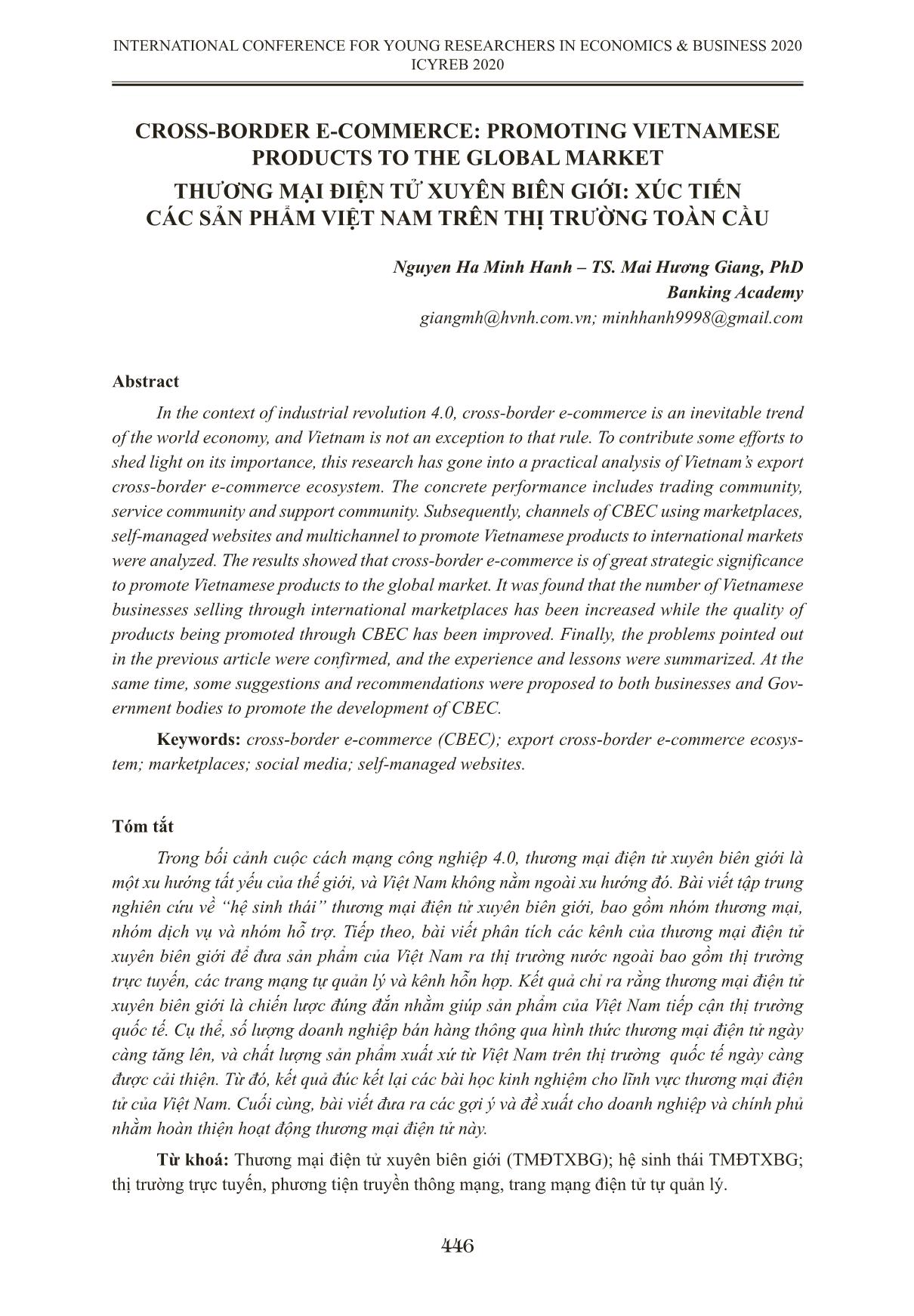
Trang 1
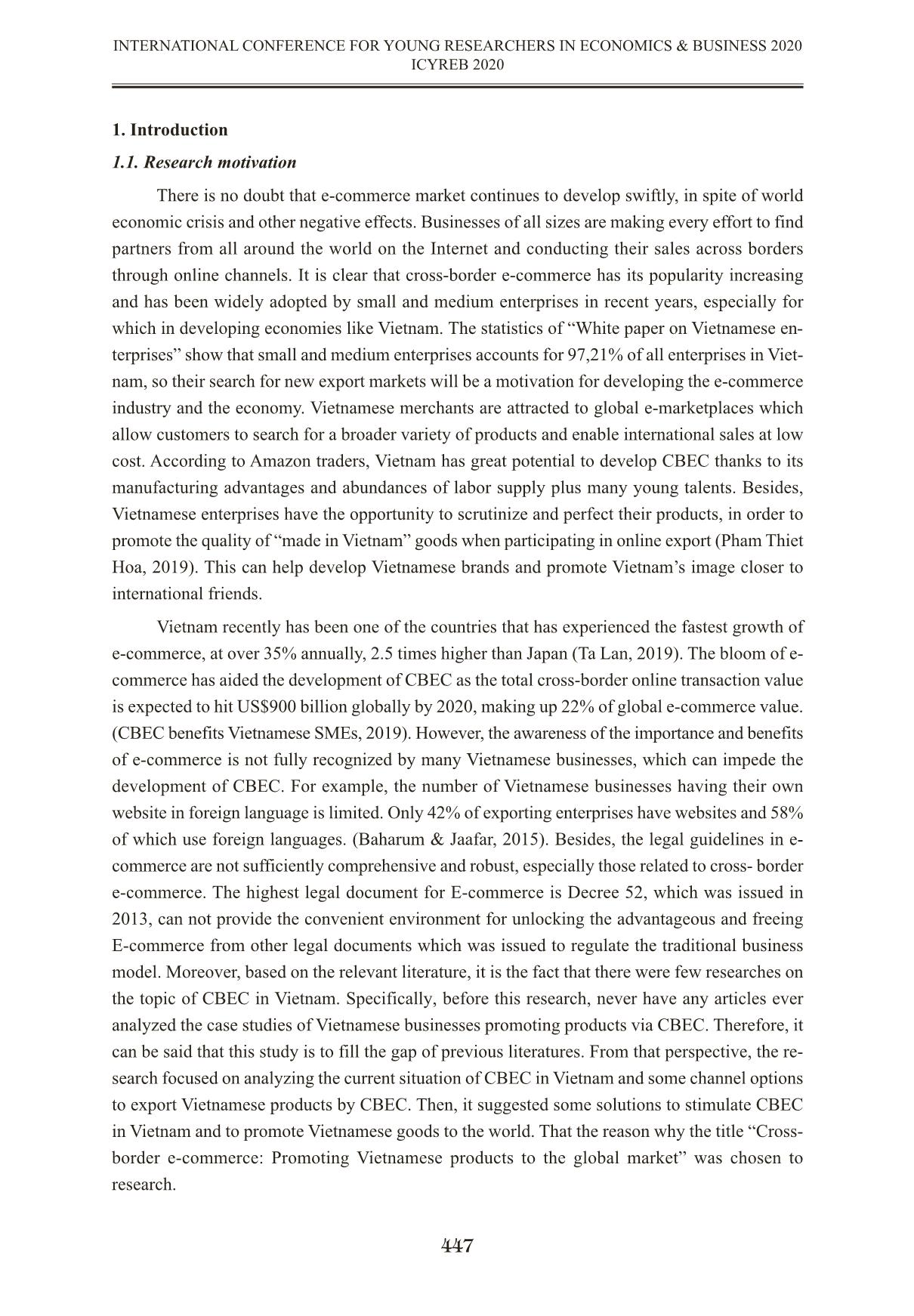
Trang 2
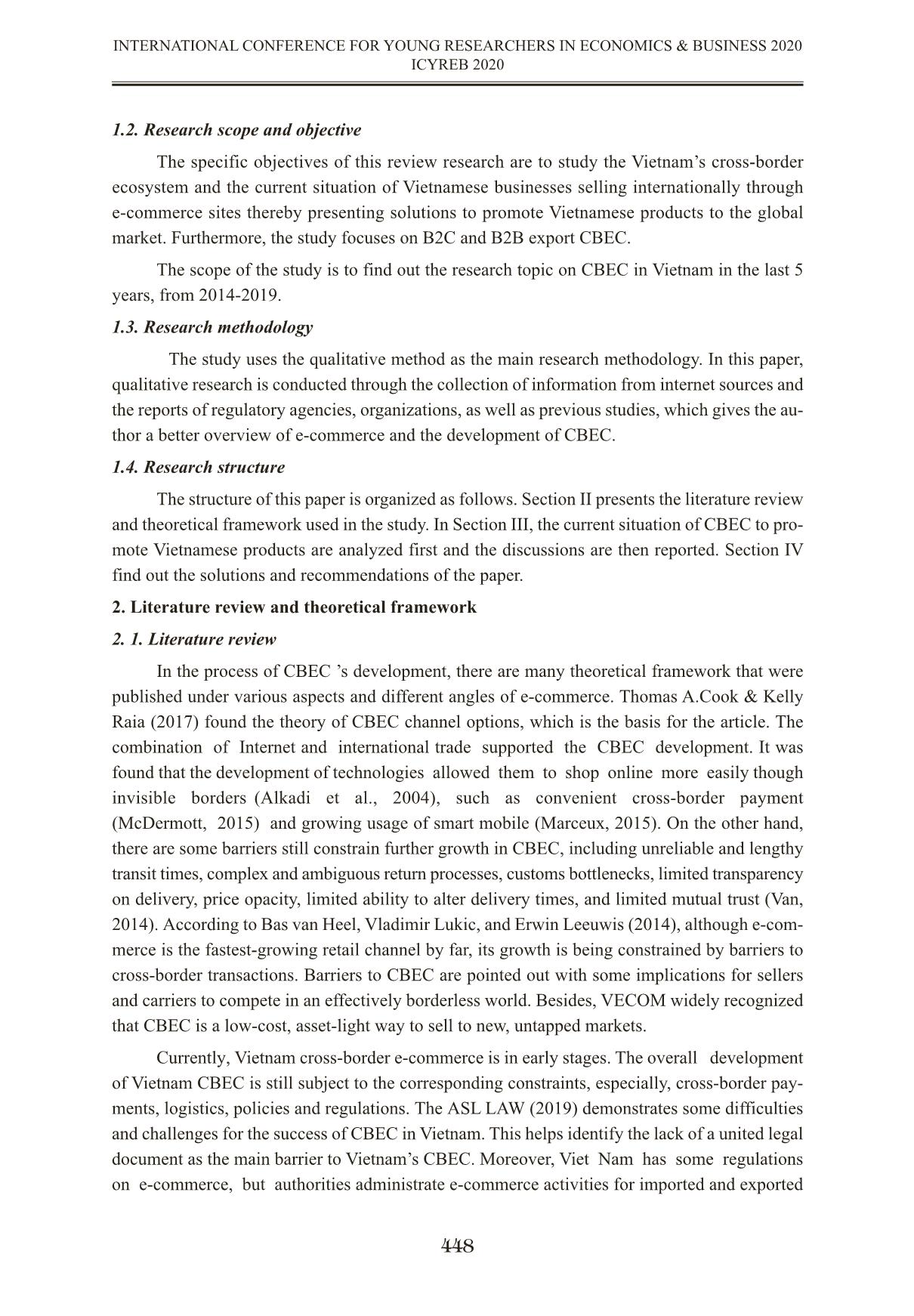
Trang 3
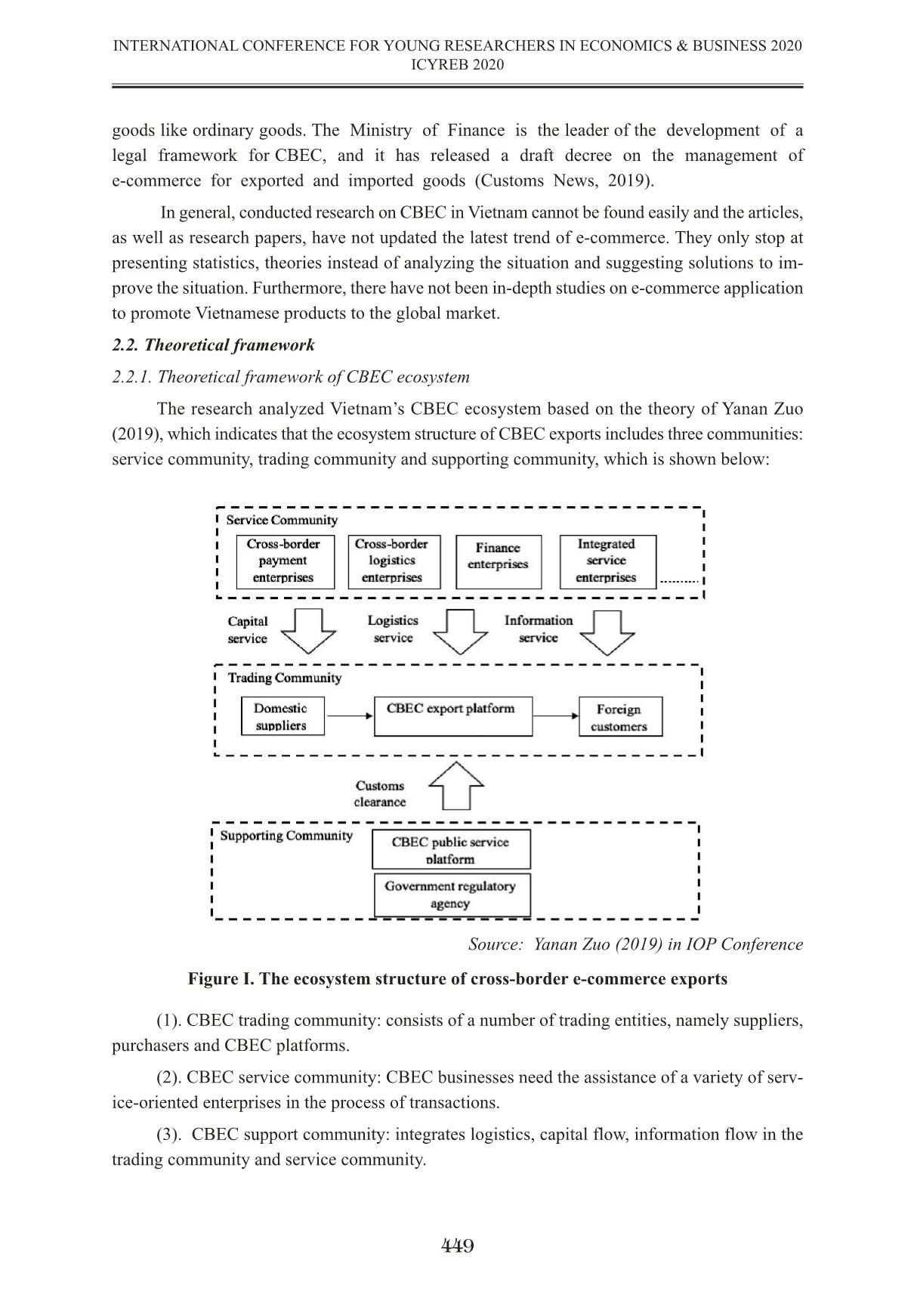
Trang 4
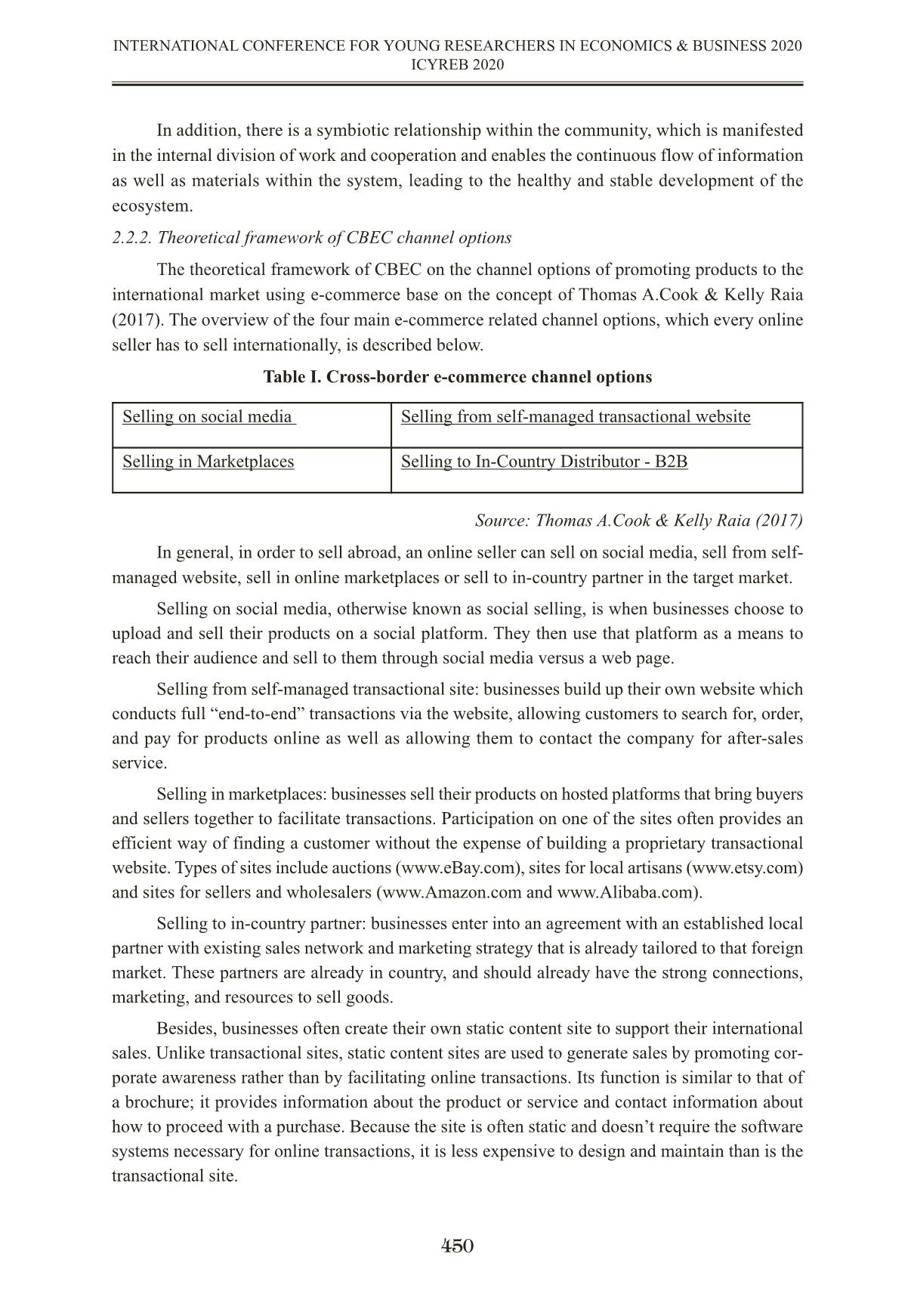
Trang 5
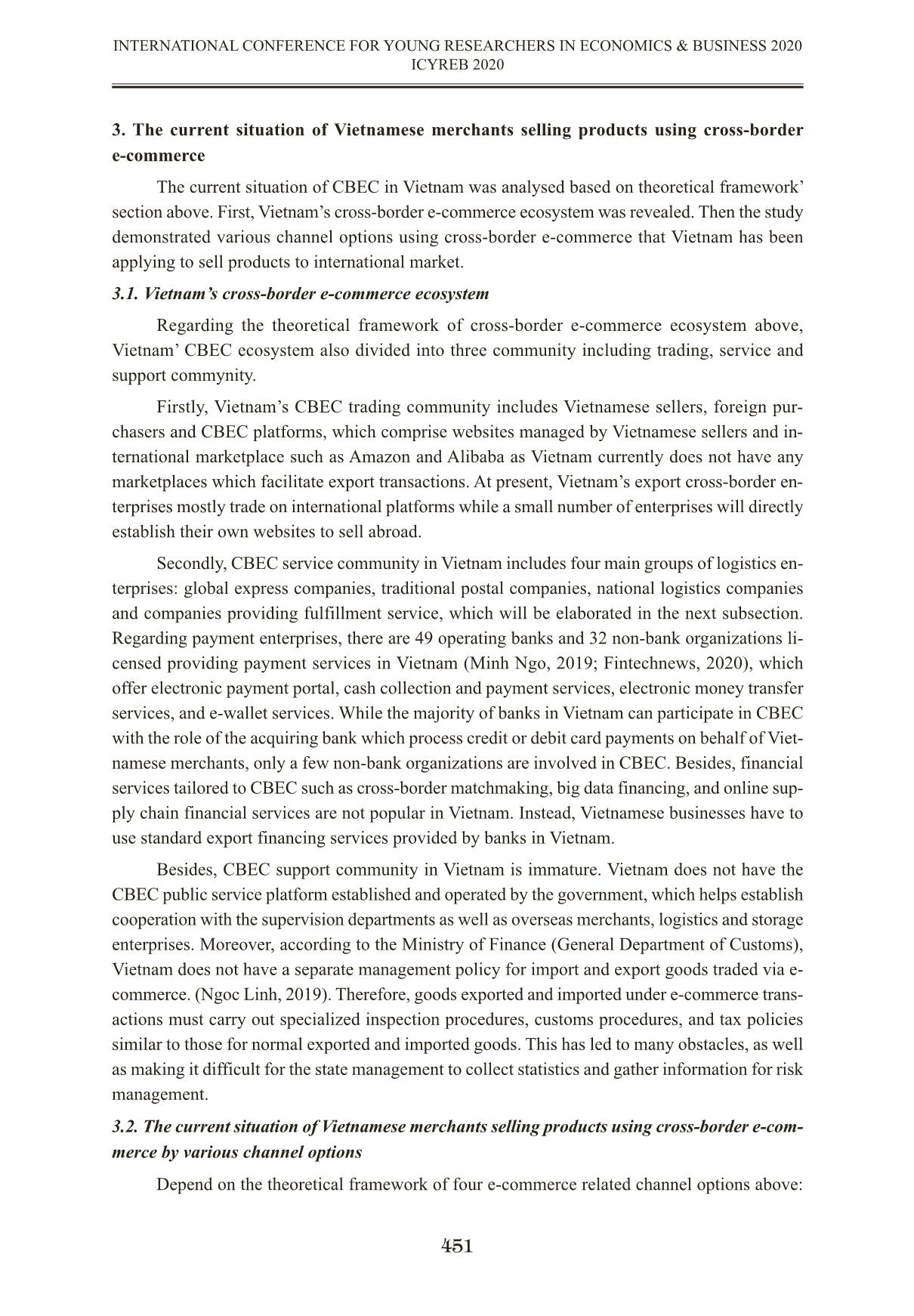
Trang 6
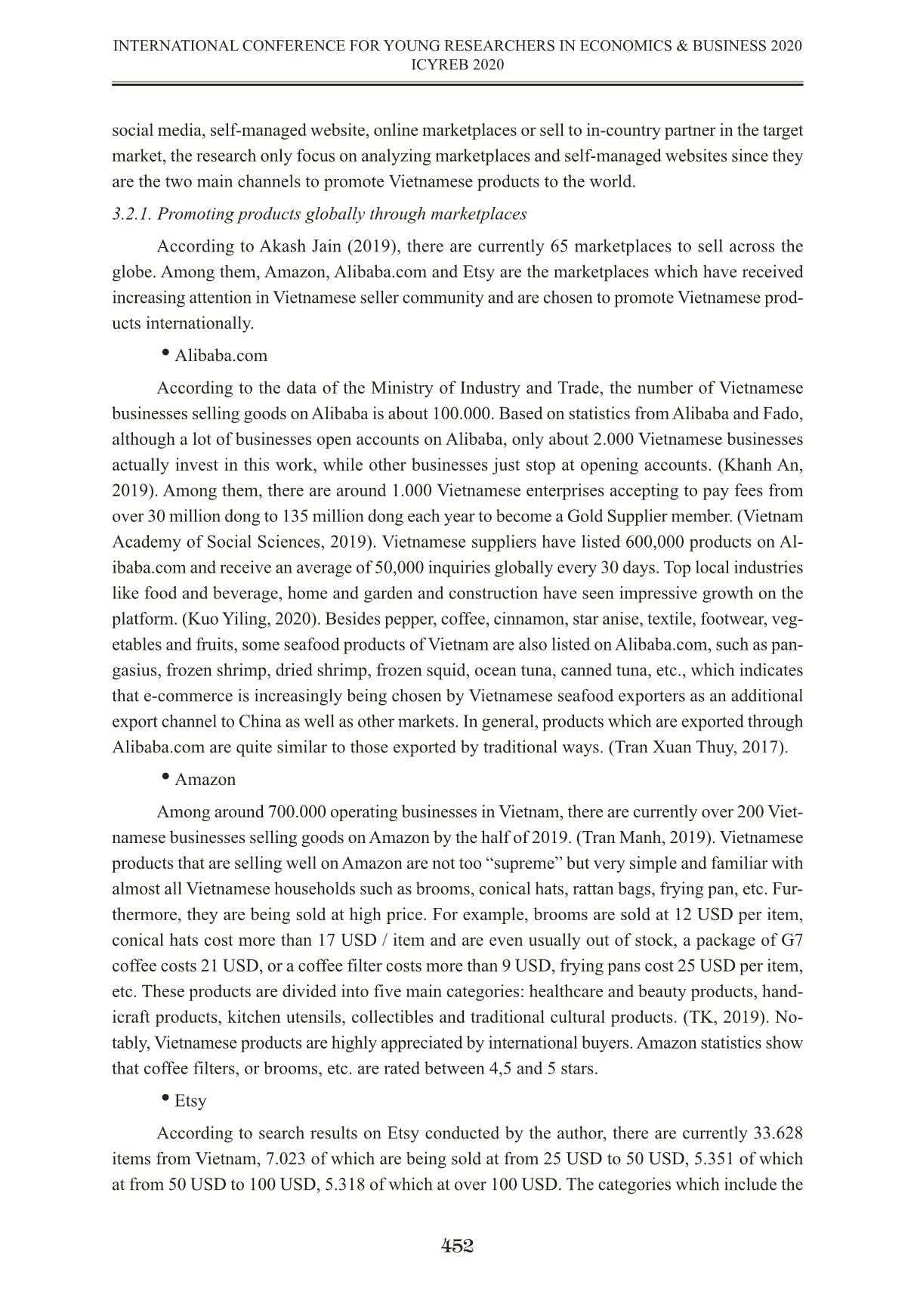
Trang 7
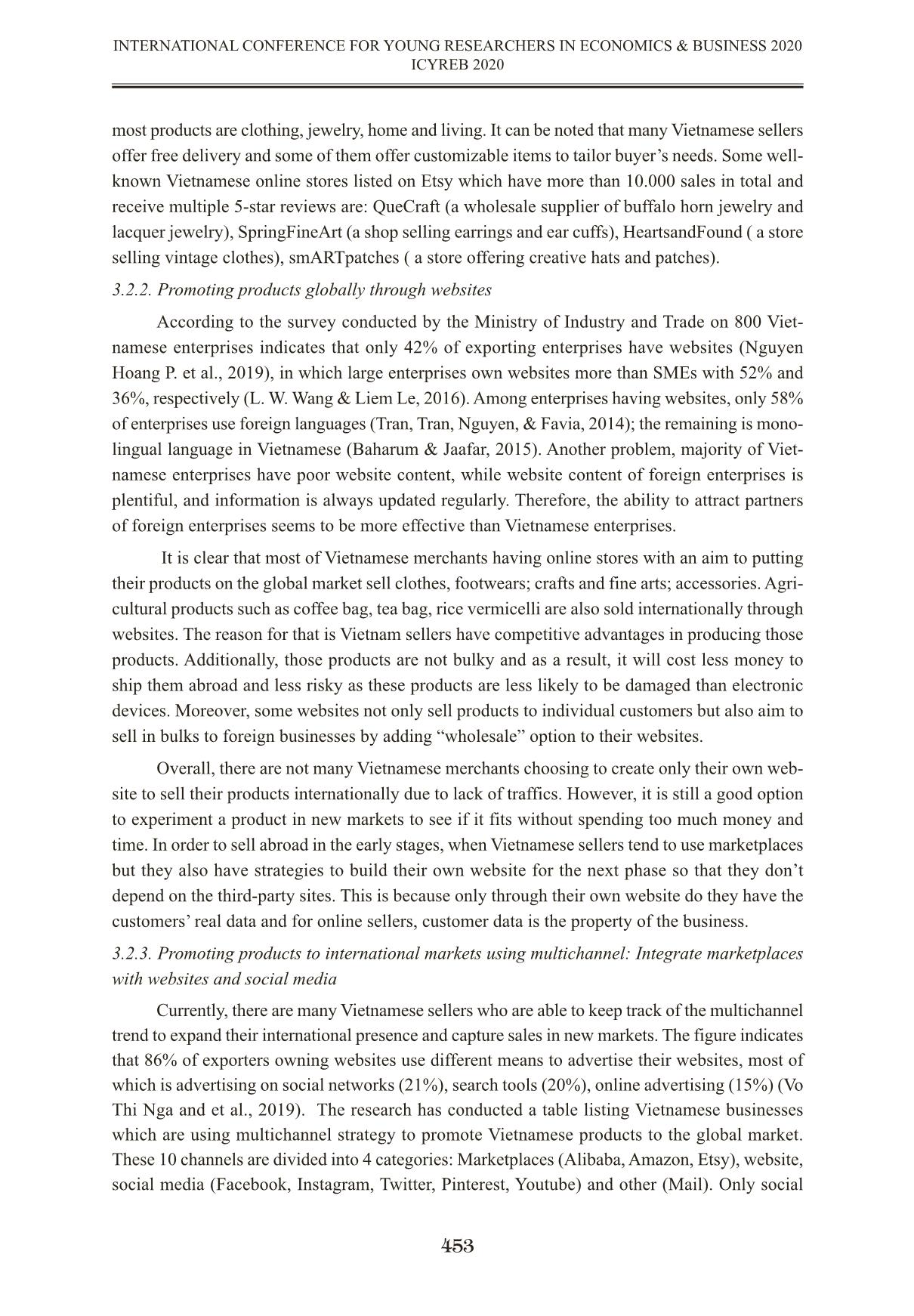
Trang 8
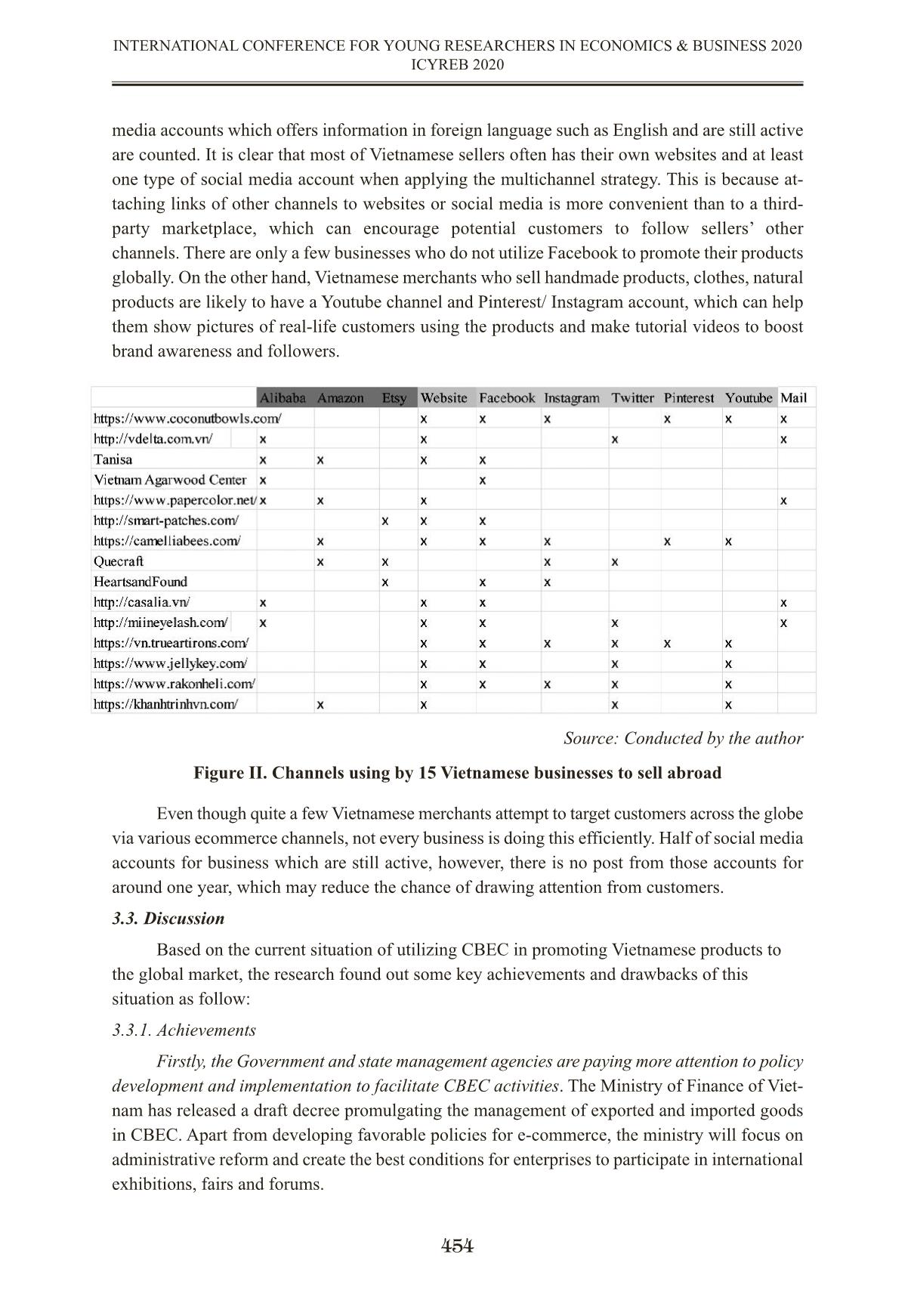
Trang 9
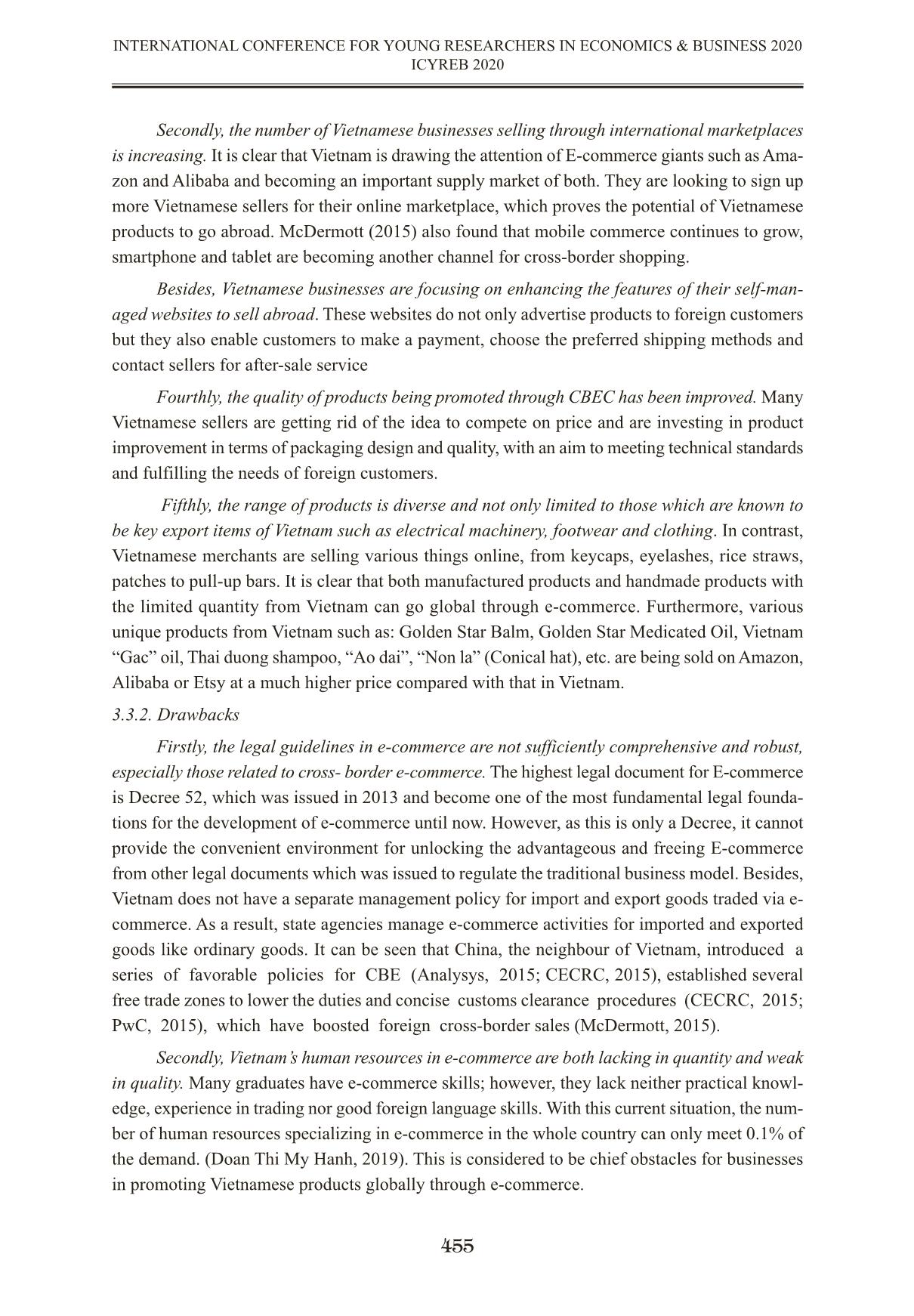
Trang 10
Tải về để xem bản đầy đủ
Tóm tắt nội dung tài liệu: Thương mại điện tử xuyên biên giới: Xúc tiến các sản phẩm Việt Nam trên thị trường toàn cầu
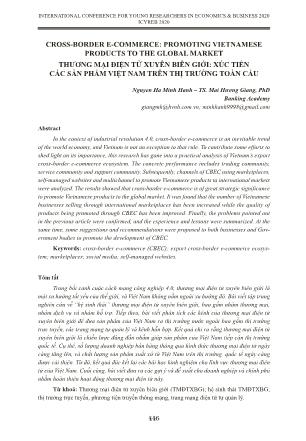
CROSS-BORDER E-COMMERCE: PROMOTING VIETNAMESE PRODUCTS TO THE GLOBAL MARKET THƯƠNG MẠI ĐIỆN TỬ XUYÊN BIÊN GIỚI: XÚC TIẾN CÁC SẢN PHẨM VIỆT NAM TRÊN THỊ TRƯỜNG TOÀN CẦU Nguyen Ha Minh Hanh – TS. Mai Hương Giang, PhD Banking Academy giangmh@hvnh.com.vn; minhhanh9998@gmail.com Abstract In the context of industrial revolution 4.0, cross-border e-commerce is an inevitable trend of the world economy, and Vietnam is not an exception to that rule. To contribute some efforts to shed light on its importance, this research has gone into a practical analysis of Vietnam’s export cross-border e-commerce ecosystem. The concrete performance includes trading community, service community and support community. Subsequently, channels of CBEC using marketplaces, self-managed websites and multichannel to promote Vietnamese products to international markets were analyzed. The results showed that cross-border e-commerce is of great strategic significance to promote Vietnamese products to the global market. It was found that the number of Vietnamese businesses selling through international marketplaces has been increased while the quality of products being promoted through CBEC has been improved. Finally, the problems pointed out in the previous article were confirmed, and the experience and lessons were summarized. At the same time, some suggestions and recommendations were proposed to both businesses and Gov- ernment bodies to promote the development of CBEC. Keywords: cross-border e-commerce (CBEC); export cross-border e-commerce ecosys- tem; marketplaces; social media; self-managed websites. Tóm tắt Trong bối cảnh cuộc cách mạng công nghiệp 4.0, thương mại điện tử xuyên biên giới là một xu hướng tất yếu của thế giới, và Việt Nam không nằm ngoài xu hướng đó. Bài viết tập trung nghiên cứu về “hệ sinh thái” thương mại điện tử xuyên biên giới, bao gồm nhóm thương mại, nhóm dịch vụ và nhóm hỗ trợ. Tiếp theo, bài viết phân tích các kênh của thương mại điện tử xuyên biên giới để đưa sản phẩm của Việt Nam ra thị trường nước ngoài bao gồm thị trường trực tuyến, các trang mạng tự quản lý và kênh hỗn hợp. Kết quả chỉ ra rằng thương mại điện tử xuyên biên giới là chiến lược đúng đắn nhằm giúp sản phẩm của Việt Nam tiếp cận thị trường quốc tế. Cụ thể, số lượng doanh nghiệp bán hàng thông qua hình thức thương mại điện tử ngày càng tăng lên, và chất lượng sản phẩm xuất xứ từ Việt Nam trên thị trường quốc tế ngày càng được cải thiện. Từ đó, kết quả đúc kết lại các bài học kinh nghiệm cho lĩnh vực thương mại điện tử của Việt Nam. Cuối cùng, bài viết đưa ra các gợi ý và đề xuất cho doanh nghiệp và chính phủ nhằm hoàn thiện hoạt động thương mại điện tử này. Từ khoá: Thương mại điện tử xuyên biên giới (TMĐTXBG); hệ sinh thái TMĐTXBG; thị trường trực tuyến, phương tiện truyền thông mạng, trang mạng điện tử tự quản lý. 446 INTERNATIONAL CONFERENCE FOR YOUNG RESEARCHERS IN ECONOMICS & BUSINESS 2020 ICYREB 2020 1. Introduction 1.1. Research motivation There is no doubt that e-commerce market continues to develop swiftly, in spite of world economic crisis and other negative effects. Businesses of all sizes are making every effort to find partners from all around the world on the Internet and conducting their sales across borders through online channels. It is clear that cross-border e-commerce has its popularity increasing and has been widely adopted by small and medium enterprises in recent years, especially for which in developing economies like Vietnam. The statistics of “White paper on Vietnamese en- terprises” show that small and medium enterprises accounts for 97,21% of all enterprises in Viet- nam, so their search for new export markets will be a motivation for developing the e-commerce industry and the economy. Vietnamese merchants are attracted to global e-marketplaces which allow customers to search for a broader variety of products and enable international sales at low cost. According to Amazon traders, Vietnam has great potential to develop CBEC thanks to its manufacturing advantages and abundances of labor supply plus many young talents. Besides, Vietnamese enterprises have the opportunity to scrutinize and perfect their products, in order to promote the quality of “made in Vietnam” goods when participating in online export (Pham Thiet Hoa, 2019). This can help develop Vietnamese brands and promote Vietnam’s image closer to international friends. Vietnam recently has been one of the countries that has experienced the fastest growth of e-commerce, at over 35% annually, 2.5 times higher than Japan (Ta Lan, 2019). The bloom of e- commerce has aided the development of CBEC as the total cross-border online transaction value is expected to hit US$900 billion globally by 2020, making up 22% of global e-commerce value. (CBEC benefits Vietnamese SMEs, 2019). However, the awareness of the importance and benefits of e-commerce is not fully recognized by many Vietnamese businesses, wh ... cross-border e-commerce exports * Building a management system of e-commerce activities to connect stakeholders The government should build an electronic port model to connect customs, logistic com- panies, banks in the process in order to speed up the transactions. In the meantime, the department specialized in controlling the quality of goods through CBEC transactions should be established and the mechanism allowing exemption from inspection for the electronic transactions having value under a specific amount to reduce time and volume of goods to be inspected * Perfecting the legal environment For e-commerce to flourish, it is necessary to improve the legal environment, through the enactment and implementation of laws and bylaws regulating commercial activities, adapting to international laws and international practices on e-commerce transactions. * Implementation of credit information disclosure system The credit rating standards should be set up to define the credit rating for the transaction subjects and to show the credit rating of the subjects to the public. After completing an electronic transaction with a foreign company, Vietnamese businesses can leave a credit rating on the system and every business which registers with the authorities can log into the system and see the rating. In the meantime, a blacklist system should be implemented. For those businesses or enterprises with low credit rating, they should be named in the credit blacklist and transactions with them should be restricted to purify the trading environment of Vietnam’s CBEC. * Building a system to ensure safety and security Businesses and the state need to join hands to create a reliable electronic security system, using internationally recognized and coherent means to combat illegal access from unsafe actions to steal personal information. The state should take the lead in making regulations and laws on information security and guide businesses to comply with these regulations. In the meantime, the penalty for acts of stealing personal information and infringing intellectual property rights in e- commerce should be harsher. 4.1.2. Solutions to improve the quality and quantity of human resources * Altering the education of e-commerce at universities 456 INTERNATIONAL CONFERENCE FOR YOUNG RESEARCHERS IN ECONOMICS & BUSINESS 2020 ICYREB 2020 Ministry of Education and Training should encourage universities to establish the faculty of e-commerce and assist them in composing the study program to fit the current situation of Vietnam. In the meantime, vocational guidance sessions should be organized to introduce the po- tentials of e-commerce and job opportunities to students. * Stakeholders should assist businesses in human resource training and the development of an e-commerce training plan for businesses. Organizations and companies in the related field such as logistics, insurance, banking should regularly organize meetings to exchange practical knowledge of e-commerce. At the same time, the state agencies also need to encourage businesses to take part in the international E-Com- merce conferences and courses hosted by Amazon Global to bring Vietnamese enterprises closer to marketplace platforms. 4.1.3. Solutions to improve the efficiency of cross-border e-commerce activities * Developing policies on capital support for SMEs to sell on international marketplaces in the early stage. Vietnamese enterprises with small and medium scale have insufficient financial capacity to pay for extra features. Therefore, it is necessary to have policies on low-interest loans to help businesses overcome the initial difficulty. * Completing the necessary infrastructure, invest in developing and applying new tech- nologies in e-commerce The enhancement of infrastructure and technology applications is the premise for e-com- merce to develop more firmly and in the long run. Businesses need to proactively allocate budget to spend on e-commerce investment with a certain cost. In addition, businesses can also invest in specialized human resources to invent their own proprietary technology products to save costs and keep customer information confidential. If businesses can keep good security, it will be easy for them to build trust with customers thereby improving the position of the company in cus- tomers’ minds. 4.1.4. Solutions to enhance the competitiveness of Vietnamese businesses * Branding online Developing products is also an important solution. In particular, the authorities should build solutions to help small and medium enterprises deploy e-commerce applications. Geographical indications for some specialty and indigenous products have been created, however, the produc- tion scale of these products is too small. Therefore, the Government should have policies to sup- port businesses and associations to build brands through: a) Planning and building production areas; b) Developing a system of product standards or harmonize international standards; c) brand- ing on the media; d) providing support for participation in trade fairs and exhibitions; e) support- ing businesses in creating websites and participating in international marketplaces. * Completing the necessary infrastructure, invest in developing and applying new tech- nologies in e-commerce The enhancement of infrastructure and technology applications is the premise for e-com- 457 INTERNATIONAL CONFERENCE FOR YOUNG RESEARCHERS IN ECONOMICS & BUSINESS 2020 ICYREB 2020 merce to develop more firmly and in the long run. In addition, businesses can also invest in spe- cialized human resources to invent their own proprietary technology products to save costs and keep customer information confidential. If businesses can keep good security, it will be easy for them to build trust with customers thereby improving the position of the company in customers’ minds. 4.2. Recommendations 4.2.1. Recommendations to the government and state agencies The state needs to focus on developing transport infrastructure along with the development of multimodal transport and logistics. The state needs to invest in the construction of roads, rail- ways, ports, etc.; creating favorable conditions for businesses to choose the mode of transporting goods to maximize profits. Besides, state agencies should encourage banking institutions and payment institutions to provide payment services for international e-commerce by simplifying the process of currency conversion and tax calculation, establishing connections with multiple payment options, improving security and reducing fraud. 4.2.2. Recommendations to Vietnamese businesses * Applying for a registration of intellectual property rights Intellectual property rights are not only for large companies and high technology. Viet- namese businesses can register their rights in the target country to prevent copying, pirating and the marketing of imitation products before launching their products in that country. Conducting the intellectual property rights also help Vietnam businesses check whether the products they are exporting will infringe a patent, trademark or copyright that has been filed in a foreign country. * Localizing the website to sell abroad No matter what the main channel Vietnamese businesses choose to sell abroad, they need to have their own website providing information about the products and contact information of the company to show customers their professionalism. However, only having a website is not enough to impress potential customers from all over the world. At least part of the website has to present information in the native language of the target market. A localized process takes more time, but it results in an increased familiarity and better user experience for the shoppers in that region. The first step towards localizing should be to translate the website. Besides making shop visitors feel more comfortable, it can make the website easier to find. Additionally, providing customers with prices in their currency and the preferred payment method are well worth con- sidering. * Keep the return policy straightforward, clear, formal and accessible. If customers would like to return the products to the sellers, establish rules for whom will pay the international shipping. Lastly, since it can take two weeks or more to deliver products to international customers, the return policy should provide time for delivery and for customers to evaluate their products. Businesses should also indicate clearly how the return will be processed: by cash, by credits for next purchases or a product exchange. In the meantime, businesses should keep track of all returns, exchanges and refunds and require identification for all returns to prevent any fraudulent activities from happening. 458 INTERNATIONAL CONFERENCE FOR YOUNG RESEARCHERS IN ECONOMICS & BUSINESS 2020 ICYREB 2020 Conclusions After joining in the global e-commerce community, Vietnamese businesses have made some certain progress when also successfully brought some of Vietnamese signature products to the global market through e-marketplaces and self-managed websites. There is no doubt that Viet- nam’s CBEC is thriving, however, not every merchant can take full advantage of those opportu- nities to expand their business. Therefore, this research focus on a practical analysis of the current situation of Vietnam’s CBEC based on established theoretical bases. Then, the author proposes the solutions and recommendations to improve the effectiveness of Vietnam’s CBEC. Although our findings yield important policy implications and contribute to the CBEC analysis literature, there are still has certain limitations such as the shortage of detailed information on Vietnam’s CBEC ecosystem due to the lack of time and human resources. Therefore, the au- thors hope that in the future, other researches on this topic will be conducted so that the concept of CBEC in Vietnam will become more popular with Vietnamese businesses, which can help them to be fully-prepared to enter the global market. From this, opportunities of Vietnamese products to go abroad will be larger. REFERENCES Vietnamese references 1. General Statistics Office Of Vietnam (2020), ‘Sách trắng Doanh nghiệp Việt Nam năm 2020’ 2. General Department of Vietnam Customs (2019), ‘Đề án quản lý hoạt động thương mại điện tử đối với hàng hóa xuất khẩu, nhập khẩu’, issued in August 19th, 2019. 3. Vietnam Academy of Social Sciences (2019), ‘Mô hình kinh tế mới và tác động đến năng suất lao động’, Conference “Improving national labor productivity” English references 4. Baharum, A. & Jaafar, A. (2015), Identifying the importance of web objects: A study of ASEAN perspectives. In Lecture Notes in Computer Science. 5. McDermott, K.(2015), Key Business Drivers and Opportunities in Cross-Border Ecom- merce, Amsterdam: Payvision Publications. 6. Thomas A.Cook & Kelly Raia (2017), page 314, Mastering Import and Export Man- agement 3rd edition, AMACOM, the United States of America 7. Zhao, X. (2019) ‘A New Mode of Cross-Border E-Business Export Logistics Based on Value Chain’. Open Journal of Business and Management, City Institute of Dalian University of Technology, Dalian, China 8. Vo Thi Nga, Chovancová Miloslava and Ho Thanh Tri (2019), ‘A major boost to the website performance of up-scale hotels in Vietnam’, Management & Marketing, Sciendo, vol. 14(1), pages 14-30 9. Vietnam E-commerce Association (2019), ‘Vietnam Business Index 2019 Report’ 459 INTERNATIONAL CONFERENCE FOR YOUNG RESEARCHERS IN ECONOMICS & BUSINESS 2020 ICYREB 2020 10. Yanan Zuo (2019) ‘Research on China’s export CBEC ecosystem: a case study of Dun- huang Network’ in IOP Conference Series: Materials Science and Engineering Websites Arkadiusz K. & Wojciech Z. (2016), ‘Conception of integrator in CBEC’, Scientific Journal of Logistics. Boxme Asia (no published year), ‘10 Things About Vietnam Ecommerce You Have To Ex- perience It Yourself’, retrieved on Sep 30th, 2020 Khanh An (2019), ‘Alibaba bắt tay đối tác Việt hỗ trợ doanh nghiệp bán hàng xuyên biên giới’, retrieved on Sep 26th, 2020, from https://export.fado.vn/n/alibaba-bat-tay-doi-tac- viet-ho-tro-doanh-nghiep-ban-hang-xuyen-bien-gioi/ Marceux, P.(2015), “What are the Main E-Commerce Drivers in Emerging Mar- kets?” N.Binh (2019), ‘Người Việt bán hàng trên Amazon có tốc độ tăng trưởng cao nhất khu vực’, retrieved on Sep 26th, 2020, from < https://tuoitre.vn/nguoi-viet-ban-hang-tren-amazon- co-toc-do-tang-truong-cao-nhat-khu-vuc-20191204205033546.htm> Ngoc Linh (2019), ‘Thương mại điện tử đối với hàng hóa xuất nhập khẩu: Bộ Tài chính dự kiến đối tượng quản lý’, retrieved on Sep 24th, 2020, from < https://haiquanonline.com.vn/thuong-mai-dien-tu-doi-voi-hang-hoa-xuat-nhap-khau-bo-tai- chinh-du-kien-doi-tuong-quan-ly-110687.html> Ngoc Linh (2019), ‘Xuất khẩu trực tuyến trong bối cảnh Việt Nam tham gia các hiệp định thương mại’, , from Nguyen Anh (2019), “Hạ tầng kinh tế số: Bộc lộ nhiều hạn chế”, retrieved on Sep 24th, 2020, from The Hoang (2019), ‘Gian nan đưa hàng Việt lên Amazon’, retrieved on Sep 26th, 2020, from https://tinnhanhchungkhoan.vn/thuong-truong/gian-nan-dua-hang-viet-len-amazon- 259429.html TK (2019), ‘Hàng loạt sản phẩm truyền thống của Việt Nam được bán với giá cực cao trên Amazon, eBay’, retrieved on Sep 26th, 2020, from < https://cafef.vn/hang-loat-san-pham-truyen- thong-cua-viet-nam-duoc-ban-voi-gia-cuc-cao-tren-amazon-ebay-20190820223423097.chn> Tran Manh (2019), ‘Mỏ vàng” Amazon và giấc mộng làm giàu’, retrieved on Sep 26th, 2020, from Tran Xuan Thuy (2017), interviewed in ‘Cà phê, hồ tiêu, nông sản Việt đang xuất khẩu qua nền tảng Alibaba’, retrieved on Sep 26th, 2020, from https://visimex.com/news/6531-ca-phe- ho-tieu-nong-san-viet-dang-xuat-khau-qua-nen-tang-alibaba-en.html Vien Thong (2018), ‘Amazon, Alibaba seek Vietnamese sellers’, retrieved on Sep 26th, 2020 Van Heel, B.; Lukic, V.; and Leeuwis, E. (2014). Cross-border e-commerce makes the world flatter. tail_cross_border_ecommerce_makes_world_flatter/ 460 INTERNATIONAL CONFERENCE FOR YOUNG RESEARCHERS IN ECONOMICS & BUSINESS 2020 ICYREB 2020 Yen Khe (2019), ‘Nomura Holdings: Việt Nam đứng đầu danh sách hưởng lợi từ chiến tranh thương mại Mỹ - Trung’, retrieved on Sep 26th, 2020, from < https://vietnambiz.vn/nomura- holdings-viet-nam-dung-dau-danh-sach-huong-loi-tu-chien-tranh-thuong-mai-my-trung- 20190604151733303.htm> Website of Alibaba , retrieved on Sep 26th, 2020 Website of Buildwithhttps://trends.builtwith.com/shop/Shopify/Vietnam, retrieved on Sep 26th, 2020 Website of Etsy , retrieved on Sep 26th, 2020 Website of VNNIC , retrieved on Sep 26th, 2020 461 INTERNATIONAL CONFERENCE FOR YOUNG RESEARCHERS IN ECONOMICS & BUSINESS 2020 ICYREB 2020
File đính kèm:
 thuong_mai_dien_tu_xuyen_bien_gioi_xuc_tien_cac_san_pham_vie.pdf
thuong_mai_dien_tu_xuyen_bien_gioi_xuc_tien_cac_san_pham_vie.pdf

